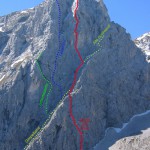Dezember 2014
AAJ bestätigt Erstbegehung am Shivling
Dass mir im Jahr 1996 mit Rainer Pircher am Shivling nicht nur die schnellste Besteigung auf den Shivling gelang, sondern dies auch noch auf einer völlig neuen Route geschah, erfuhr ich erst vor kurzer Zeit.
Eine portugiesische Expedition meldete sich beim AAJ mit der Information, dass sie im Spätherbst 2014 auf einer neuen Route in der Westwand bis unter den Gipfelaufschwung gekommen sind. Dafür benötigten sie zwei Hochlager, mussten aber dennoch umkehren.
Lindsay Griffin, Autor der AAJ meldete sich daraufhin bei mir, da die Indian Mountaineering Foundation eine erfolgreiche Durchsteigung der Westflanke im Frühjahr 2014 durch ein Deutsch/Schweizer Team publizierte.
Nach längeren Recherchen stellte er fest, dass die 1996 von mir erst begangene Route bisher nie wiederholt wurde, weil ich dies international nicht veröffentlicht hatte.
Im Frühjahr 2014 glückte unserem Team die Zweitbegehung.
India
Western Garhwal
Shivling, west face, previously unreported new route and second ascent. In May our five member expedition planned to attempt two routes on Shivling (6,543m). Rainer Treppte and I (German) wanted to try a new route on the left side of the northeast face, while Niels Delenk, Henning Stoll (both German), and Heiner Heim (Switzerland) would climb the normal route up the west ridge and prepare the descent for Treppte and me.
We stayed at base camp for three weeks, during which time we had a constant fight with snowfall: fresh snow fell to a depth of one meter. The weather was extremely unstable, and as India strictly prohibits the use of satellite phones, we had no contact with the outside world and therefore no forecasts. We made a few unsuccessful attempts on the northeast face, always thwarted due to storm and avalanche danger.
Just before our departure, I decided to try a speed ascent of the mountain with Delenk, and opted for my 1996 route.
Shivling’s dramatic shape and its sheer flanks make it a forbidding prospect. Only on one side is the angle more amenable; the west face. Unfortunately, it is overhung by a huge, broad serac barrier. A low relief mixed rocky ridge – the west face normal route – rises to the middle of the serac barrier, and was climbed in 1974 to make the first ascent of the mountain. The technical difficulties are short, and icefall from the serac generally passes to either side. Although the line through the barrier varies annually, it normally takes climbers to the col between Shivling’s two summits.
In September 1996 I arrived with three other climbers, planning to make the second ascent of the east ridge (Bettembourg-Child-White-Scott, 1983). However, the team dynamics were not right, and there were a number of internal problems. We gave up the idea [later in the month Bouchard and Richey made the second ascent, in alpine style]. In the last week of the expedition I studied a route on the west face that would give a rapid ascent to the summit. Rainer Picher and I left base camp and made a bivouac under the northwest ridge. After four hours rest we set off on our new line, which climbs part of the northwest ridge, then the west face to the serac, before making a rising traverse left to the upper northwest ridge and main summit. It took eight hours. We rested 30 minutes on top, then descended to base camp the same day. Due to the large exposure to the serac, I vowed never to climb this route again.
I started the repeat ascent with Niels Delenk in the afternoon of May 27, 2014. Hampered by fresh snow, by late evening we had reached 5,200m on the approach to the crest of the northwest ridge, and stopped there to bivouac. The weather began to clear and the temperature fell to -25°C. After a few hours rest we began to climb, finding it tricky to negotiate snow-covered slabs in the dark. However, we were in good shape, changed lead often, and in early morning could look up the great face and see the serac above. It was possible to follow my 1996 line, and we moved fast, from rock pillar to rock pillar, to minimize the objective danger. At 10 a.m. we reached the summit, and then reversed our route all the way to our bivouac site. That same evening the other three members arrived, and we slept there together. The following day they followed our track and also reached the summit. We all reached base camp on the 29th. The steepest ice on the route is 60-70°, with some mixed ground at M4-M5. However, whilst the technical difficulties are not high, the route is exposed to the giant serac for a significant distance, and is only suitable for a speed ascent. It’s a mental challenge for fast climbers.
Walter Hoelzler, Germany
Das American Alpine Journal ist eine jährlich erscheinende Zeitschrift, publiziert vom American Alpine Club. Ziel ist die Dokumentation besonderer alpinistischer Leistungen in den Hochgebirgen der Welt; Untertitel: “The World’s Most Significant Climbs”. (Quelle: Wikipedia)
Anm. Auf einen Eintrag im AAJ darf man schon ein bisschen stolz sein.
Meine herausragendsten Erstbegehungen über 300 Meter Wandhöhe:
Europa
Gimpel Nordwand (Österreich) “Schrei aus Stein”
Rubihorn Nordwand (Deutschland) “Ice on the rocks” in Verbindung mit “Eis am Stil”
Afrika:
Mt. Kenia Ostwand (Kenia) “African Skyline” in Verbindung mit “Way to Skyline”
Asien:
Bhagirathi III – Direkter Südwestpfeiler (Indien) “Stairway to heaven”
Shivling westface (Indien) “German route”
- Gimpel – Schrei aus Stein
- Rubihorn Nordwand
- Mount Kenia, 5200m
- Bhagirathi III mit dem direkten Südwestpfeiler
- Shivling – Expedition 2014






